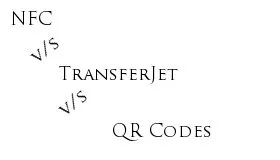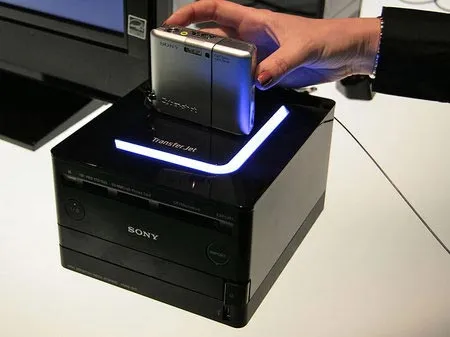Close Range Technologies for Mobiles: TransferJet v/s NFCv/sQRCodes

- Close range technologies have been under the scanner of late and a debate has been raging on as to which technology would be the most viable. Many recent posts in the blogosphere outline apprehension about NFC (Near Field Communication), a relatively matured technology but still in take-off mode. I got in touch with Vaibhav Puri, founder at Taggito (NFC solutions providers) for an extensive conversation on close range technologies and his takeaways from the recently concluded Mobile Congress event in Barcelona where these technologies were at the heart of discussions. NFC is a contactless technology that allows devices to communicate among themselves by a simple tap or touch. As per an interview with Rene Penning de Vries, CTO of NXP Semiconductors (co-inventors of NFC), this technology has three capabilities:It emulates a credit card. You touch your NFC enabled phone to a product and the payment can made
- Peer-to-peer communication
- As a reader. If there is an NFC-enabled board, one can take the phone close to the board and upload or download information.
This looks great! But then why is there a buzz about the death of NFC? Steps in, Transferjet.

Transferjet is a technology, still in the works by Sony and few other Japanese firms, which was recently unveiled to great awe. How is it better? Transferjet claims to have a data throughput of 375 Mbps which is far higher than existing technologies such as Bluetooth or even NFC. “This is definitely a huge advantage but Transferjet still has a long way to go in convincing the market of its commerical viability, security and regulatory restrictions. Currently, even the costs associated with transferjet are not known.” said Vaibhav.
NFC has a definite upper hand in terms of penetration with a number of phone manufacturers such as Sony, Panasonic and HTC announcing NFC enabled phone but Sony communicated (on 24th February,2012) their attempt to commercialize the technology and bring in a component that will allow Trasferjet to hit markets in a year.
NFC has an advantage of allowing businesses to use passive tags to communicate with their customers. These tags are cost-effective and can be conveniently placed at a location. For the true potential of applications that use Transferjet to be realized, the tags would need to have a lot more memory and therefore, quite a bit more expensive. “Another challenge for Transferjet is regulatory. Transferjet works at 4.48Ghz which is currently an unregulated bandwidth in US, Europe and Japan but with the grappling issue of spectrum shortage and the latest rounds of spectrum re-farming in Europe, Transjet would need to in some form hedge this risk before manufacturers put down investments into this technology.” said Vaibhav.
Why aren’t we talking QR codes?
Amidst these sophisticated technologies, QR (Quick Response) codes have lost the shimmer. QR codes are still in the race but might end up remaining as a transitional technology.
Advantages:
- Anyone with a mobile phone having a camera phone can use this.
- Running an advertising campaign is cheap as printing the QR code is the only charge incurred
Disadvantages:
- It doesn’t simplify the process too much as installing an app that can read the QR code is still a necessity.
- There are a few hassles as all the apps are not able to read all the codes.
- QR codes are not very attractive to the non-tech crowd. It has an inherent characteristic of looking complex.
All three are fascinating technologies if implemented properly, like the recent experiment by Paypal in Singapore was a phenomenal example of using QR codes the right way. NFC is heading the race currently but it’d be interesting to see how the face of close range technologies shapes up in the future.
Resources:
Mashable's article on TransferJet replacing NFC gave birth to this comparative study. Times Of India had interviewed the CTO of NXP Semiconductors a few months ago which lead the way as a counter argument and QR codes have been around for quite a while. Also, Vaibhav Puri's inputs were invaluable.
[image credit: hothardware.com]
- Jubin Mehta






